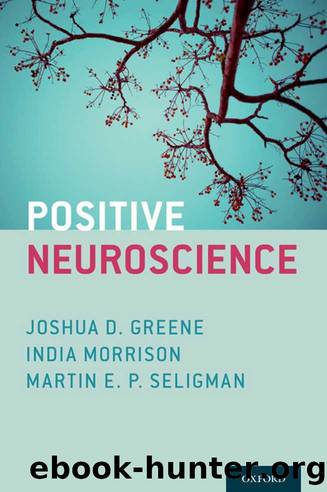Positive Neuroscience by Joshua D. Greene & India Morrison & Martin E. P. Seligman

Author:Joshua D. Greene & India Morrison & Martin E. P. Seligman
Language: eng
Format: epub
Toward a Neuroscience of Compassion
A Brain Systems-Based Model and Research Agenda
YONI K. ASHAR, JESSICA R. A N D R E W S - H A N N A , SONA DIMIDJIAN, AND TOR D. WAGER ■
Love and compassion are necessities, not luxuries. Without them, humanity cannot survive.
—The Dalai Lama
Compassion is regarded as a central virtue by many cultures and value systems. It is an essential ingredient of healthy interactions with others at every scale, from the everyday interactions within a local community to the interactions among nations that shape human well-being and suffering in profound ways. Though compassion is interpersonal, it has also been empirically linked with personal benefits, including increased positive emotions (Dunn, Aknin, & Norton, 2014; Fredrickson, Cohn, Coffey, Pek, & Finkel, 2008), improved physical health (Carson et al., 2005; Kok et al., 2013), and a reduced immunological stress response (Pace et al., 2009, 2010). Unfortunately, despite the personal and interpersonal advantages of a compassionate stance, people often respond to others’ suffering with indifference, aversion, or even gloating. A scientific understanding of how and when compassion arises could help promote a more compassionate society.
To illustrate the complexity of responding to others’ suffering, imagine encountering a disheveled elderly women begging for money on the street corner. Perhaps she seems desperately needy and frantic, or perhaps she seems jaded and worn from years of begging. Basic affective feelings—the desire to approach or avoid, elementary forms of distress, tenderness, and aversion— arise immediately, often unbidden. Simultaneously, an assortment of thoughts may present themselves, such as “It’s her fault she’s homeless,” “She probably has nowhere to sleep,” “My $2 won’t do her much good anyways,” “She seems like a sweet person,” “I can’t trust her to spend the money wisely,” and so forth. In some cases, this information is integrated to construct a schematized, gestalt “emotional meaning” (Roy, Shohamy, & Wager, 2012) regarding the situation, such as compassionately perceiving the woman as deserving of help or angrily blaming her for her suffering. All of these feelings, judgments, and emotional meanings interact, and each can constrain the evolution of the others, in a process potentially resulting in behavioral decisions such as helping or distancing. Understanding these interactions, particularly the factors that lead to the evolution of compassion versus disgust or schadenfreude, could support the development of targeted interventions to increase compassion and compassionate behavior.
There are many obstacles to studying compassion, not least among them that scholars define compassion in different ways (see Batson, 2011; Goetz, Keltner, & Simon-Thomas, 2010; Singer & Lamm, 2009 for discussions), and the boundaries between affective feelings, judgments, and emotions are conceptually permeable. The concept of “compassion” can potentially include feelings, thoughts, emotions, and behaviors (helping). Here, we operationally define compassion as a mental state arising in response to another’s suffering that motivates behavior intended to relieve their suffering. The conceptual ambiguity inherent in defining psychological processes such as “compassion” and “emotion” is a major reason to anchor concepts and definitions in the study of brain systems. Mapping compassion
Download
This site does not store any files on its server. We only index and link to content provided by other sites. Please contact the content providers to delete copyright contents if any and email us, we'll remove relevant links or contents immediately.
When Breath Becomes Air by Paul Kalanithi(7256)
Why We Sleep: Unlocking the Power of Sleep and Dreams by Matthew Walker(5637)
Paper Towns by Green John(4165)
The Immortal Life of Henrietta Lacks by Rebecca Skloot(3821)
The Sports Rules Book by Human Kinetics(3582)
Dynamic Alignment Through Imagery by Eric Franklin(3483)
ACSM's Complete Guide to Fitness & Health by ACSM(3462)
Kaplan MCAT Organic Chemistry Review: Created for MCAT 2015 (Kaplan Test Prep) by Kaplan(3419)
Introduction to Kinesiology by Shirl J. Hoffman(3297)
Livewired by David Eagleman(3117)
The River of Consciousness by Oliver Sacks(2989)
Alchemy and Alchemists by C. J. S. Thompson(2909)
The Death of the Heart by Elizabeth Bowen(2897)
Descartes' Error by Antonio Damasio(2728)
Bad Pharma by Ben Goldacre(2724)
The Gene: An Intimate History by Siddhartha Mukherjee(2488)
Kaplan MCAT Behavioral Sciences Review: Created for MCAT 2015 (Kaplan Test Prep) by Kaplan(2486)
The Fate of Rome: Climate, Disease, and the End of an Empire (The Princeton History of the Ancient World) by Kyle Harper(2431)
The Emperor of All Maladies: A Biography of Cancer by Siddhartha Mukherjee(2427)
